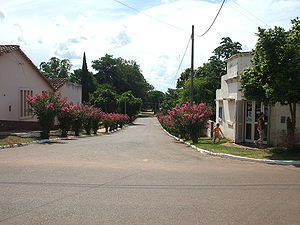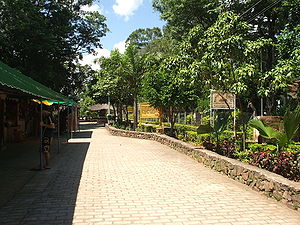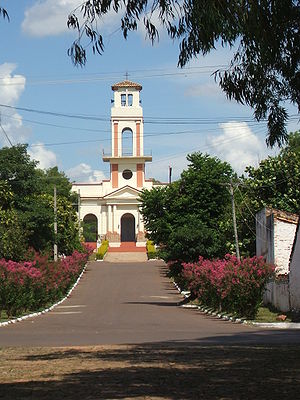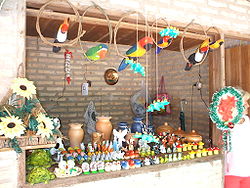
Atyrá
Encyclopedia
Atyra is an old city of Paraguay
, 61 kilometers from the country's capital, Asunción
. Located in the Altos Cordillera, it is part of the Cordillera Department
.
in 1538. The word "Atyhá" is of Guaraní
origin. It used to be a village of the natives and it was called that way because it was the place of meeting of its members.
 Located in the Altos Cordillera, the landscape of the city has great extensions of rocks that form undulations.
Located in the Altos Cordillera, the landscape of the city has great extensions of rocks that form undulations.
To the North-East: Loma Grande
To the South: Tobatí
To the West: Altos
To the South-East: limits with San Bernardino
and Ypacarai
The population density is 70 inhabitants per kilometer.
 Most of the housings in Atyra are modern, but a few are left that date from the 19th century, those show the architecture and details of the typical constructions of that time during the Colony, so there can be found houses with ceilings of hay and surrounded by trees and palms typical of the area.
Most of the housings in Atyra are modern, but a few are left that date from the 19th century, those show the architecture and details of the typical constructions of that time during the Colony, so there can be found houses with ceilings of hay and surrounded by trees and palms typical of the area.
The city is divided in an urban and a rural area. In the urban are the following neighborhoods:
In the rural area are these localities:
found it in 1539. The act of foundation was made under the shadow of three Yvapovó plants, in place that the natives used as a place of meeting, from this came the name "Atyhá" that finally became "Atyrá". In 1580, Franciscan Missioners
led by Alonso de San Buenaventura
and Fray Luis de Bolaños
, made the religious foundation of the localities: Altos
, Atyrá, Tobatí and Yaguarón.
 The church of Atyrá is nowadays a Museum of Sacred Art that exhibits beautiful cravings in wood made by the natives since 1580, with a Baroque Hispano-Guaraní style.
The church of Atyrá is nowadays a Museum of Sacred Art that exhibits beautiful cravings in wood made by the natives since 1580, with a Baroque Hispano-Guaraní style.
The building of the church started towards 1782, impelled by the Priest Almada, who also made his the responsibility of encouraging the population of the city to develop some mechanic and artisan abilities.
The church was remodeled in 1852 by command of the President of Paraguay
at that time, Carlos Antonio López. This temple was replaced in 1928, for the building that stands these days.
Since that moment, the town developed and grew around the church, as was traditional with most of the towns in Paraguay throughout its history. Three of four walls of the building served as the start of the new construction, the wall that face southeast does not present any sign of there being built more edifice.
The church is not located in the epicenter of the city; it is actually displayed more like the perspective of an avenue, as if it was the beginning or the end of the city. In its interior, it keeps the altar built in the 18th century and the statues that represent the Virgin De Los Dolores, Saint Francis, Saint Lucía, Virgin De La Candelaria, María Auxiliadora, and Saint Catalina, among others, all created under the teaching of the Franciscan Missioners.
and cattle
. But it also has oil factories and sawmills. The production of the oil comes from the industrialization of coconut
.
The people of the city also maintain the continuity of the artisan characteristics of the Colonial time, specially the work in saddlery.
 This city is known by the artisan work in leather and fabric the people of the city make. The artisans also work in the creation of wood objects. The production is exposed in a permanent market installed in the middle of the city.
This city is known by the artisan work in leather and fabric the people of the city make. The artisans also work in the creation of wood objects. The production is exposed in a permanent market installed in the middle of the city.
On October 4 is celebrated the religious holiday of Saint Francis of Asís, Patron Saint of the city.
Basilic.
 One of the most interesting activities the artisans make is the carving of wood, which is the second most important activity of the city. These objects in wood are very well known and appreciated by the citizens of Atyrá and the entire country, as well as some nearby countries. This artisan activity started in times of the Colony, when the Franciscan Missioners thought the natives. The tradition still lives in the population of the city, and keeps growing and perfecting with every generation. The usual themes for doing the carvings in wood are saints, mythological creatures, animals and some more.
One of the most interesting activities the artisans make is the carving of wood, which is the second most important activity of the city. These objects in wood are very well known and appreciated by the citizens of Atyrá and the entire country, as well as some nearby countries. This artisan activity started in times of the Colony, when the Franciscan Missioners thought the natives. The tradition still lives in the population of the city, and keeps growing and perfecting with every generation. The usual themes for doing the carvings in wood are saints, mythological creatures, animals and some more.
Another remarkable craftsmanship is work in leather. Many families work the leather and make bags, backpacks, shoes, belts, saddles, and others.
Atyrá has a rich variety of fauna and flora, especially in the area of Zanja Hú. It has several streams that are apt for swimming and practicing water sports. Carumbey means "Turtle’s stream".
 Atyrá is known as the "Cleanest city of Paraguay", the seventh most clean in America and the eighth healthiest community in the world, certificated by the World Health Organization
Atyrá is known as the "Cleanest city of Paraguay", the seventh most clean in America and the eighth healthiest community in the world, certificated by the World Health Organization
. It also was declared "Ecological Capital of Paraguay", by a government decree.
This accomplishment is due to the Municipality's initiative that has sponsored the protection of the environment and the ecological preservation among its inhabitants. This effort of the municipality and the population is noticed in the cleanliness of the city's streets.
Paraguay
Paraguay , officially the Republic of Paraguay , is a landlocked country in South America. It is bordered by Argentina to the south and southwest, Brazil to the east and northeast, and Bolivia to the northwest. Paraguay lies on both banks of the Paraguay River, which runs through the center of the...
, 61 kilometers from the country's capital, Asunción
Asunción
Asunción is the capital and largest city of Paraguay.The "Ciudad de Asunción" is an autonomous capital district not part of any department. The metropolitan area, called Gran Asunción, includes the cities of San Lorenzo, Fernando de la Mora, Lambaré, Luque, Mariano Roque Alonso, Ñemby, San...
. Located in the Altos Cordillera, it is part of the Cordillera Department
Cordillera Department
-History:During the seventeenth and eighteenth centuries this area of the country was going through a serious crisis due to population bellicosity of the Indians from Chaco. The villagers from Tobatí located north of the river Pirapo then called, had to migrate south for the continue attacks by...
.
Original name and founding
Atyrá was initially named Atyhá, founded by the governor Domingo Martínez de IralaDomingo Martínez de Irala
Domingo Martínez de Irala was a Spanish Basque conquistador.He headed for the Americas in 1535 enrolled in the expedition of Pedro de Mendoza and participated in the founding of Buenos Aires...
in 1538. The word "Atyhá" is of Guaraní
Guaraní language
Guaraní, specifically the primary variety known as Paraguayan Guaraní , is an indigenous language of South America that belongs to the Tupí–Guaraní subfamily of the Tupian languages. It is one of the official languages of Paraguay , where it is spoken by the majority of the population, and half of...
origin. It used to be a village of the natives and it was called that way because it was the place of meeting of its members.
Geography

Limits
To the North: the city of Arroyos y EsterosArroyos y Esteros
Arroyos y Esteros is a district of the Cordillera Department, Paraguay.-Etymology:Its name describes exactly the real aspect of this place, which is surrounded by swamps and streams...
To the North-East: Loma Grande
Loma Grande
Loma Grande is a district of the Cordillera Department, Paraguay....
To the South: Tobatí
To the West: Altos
Altos
Altos is a district and locality of the Cordillera Department, Paraguay.-Etymology:It is also called “Altos de Ybypytaré”, which in Guaraní means “path of the wind”, previously called “San Lorenzo de la Cordillera de los Altos”, one of the oldest cities of Paraguay...
To the South-East: limits with San Bernardino
San Bernardino, Paraguay
San Bernardino is a town and distrito in Paraguay, located on the shores of Ypacarai Lake in the Cordillera Department...
and Ypacarai
Ypacaraí Lake
Ypacaraí Lake is a major waterbody located in Paraguay about 25 km east of Asunción. The lake lies in the western part of the Asunción-Sapucai-Villarrica graben, a tectonic depression of Mesozoic age, and drains to the northwest trough Salado River into Paraguay River...
Climate
The climate is mild and dry. The average temperature is 22°C, reaching in the summer 39°C and in winter dropping to 3°C.Demography
The Atyra's population is 15.278 inhabitants, 8.004 men and 7.274 women, according to the projections of the Statistics, Polls and Census General Direction (2008).The population density is 70 inhabitants per kilometer.
Neighborhoods and districts

The city is divided in an urban and a rural area. In the urban are the following neighborhoods:
- San Antonio
- San Blás
- Las Mercedes
- María Auxiliadora
In the rural area are these localities:
- Candia
- San Vicente
- Gral. Bernardino Caballero
- Zanja hú
- Comandante Ojeda
- Caacupemí
- Tacuaty
- Mbururú
- Candia Loma
- Catumbey
- Cauguá
- Potrero
- Monte Alto
History
The governor Domingo Martínez de IralaDomingo Martínez de Irala
Domingo Martínez de Irala was a Spanish Basque conquistador.He headed for the Americas in 1535 enrolled in the expedition of Pedro de Mendoza and participated in the founding of Buenos Aires...
found it in 1539. The act of foundation was made under the shadow of three Yvapovó plants, in place that the natives used as a place of meeting, from this came the name "Atyhá" that finally became "Atyrá". In 1580, Franciscan Missioners
Franciscan
Most Franciscans are members of Roman Catholic religious orders founded by Saint Francis of Assisi. Besides Roman Catholic communities, there are also Old Catholic, Anglican, Lutheran, ecumenical and Non-denominational Franciscan communities....
led by Alonso de San Buenaventura
Alonso de San Buenaventura
Alonso de San Buenaventura was a SpanishFranciscan friar and missionary evangelist. He entered the Franciscan order at the convent of Our Lady of Loreto in Espartinas, Seville. After being ordained priest, he enlisted a group of Franciscans for missionary work in Paraguay...
and Fray Luis de Bolaños
Luis de Bolaños
Luis de Bolaños was a Spanish Franciscan friar and missionary evangelist, initiator of the system of reductions in Paraguay and northeastern Argentina....
, made the religious foundation of the localities: Altos
Altos
Altos is a district and locality of the Cordillera Department, Paraguay.-Etymology:It is also called “Altos de Ybypytaré”, which in Guaraní means “path of the wind”, previously called “San Lorenzo de la Cordillera de los Altos”, one of the oldest cities of Paraguay...
, Atyrá, Tobatí and Yaguarón.
Church of Atyra

The building of the church started towards 1782, impelled by the Priest Almada, who also made his the responsibility of encouraging the population of the city to develop some mechanic and artisan abilities.
The church was remodeled in 1852 by command of the President of Paraguay
President of Paraguay
The President of Paraguay is according to the Paraguayan Constitution the Chief of the Executive branch of the Government of Paraguay...
at that time, Carlos Antonio López. This temple was replaced in 1928, for the building that stands these days.
Since that moment, the town developed and grew around the church, as was traditional with most of the towns in Paraguay throughout its history. Three of four walls of the building served as the start of the new construction, the wall that face southeast does not present any sign of there being built more edifice.
The church is not located in the epicenter of the city; it is actually displayed more like the perspective of an avenue, as if it was the beginning or the end of the city. In its interior, it keeps the altar built in the 18th century and the statues that represent the Virgin De Los Dolores, Saint Francis, Saint Lucía, Virgin De La Candelaria, María Auxiliadora, and Saint Catalina, among others, all created under the teaching of the Franciscan Missioners.
Economy
The population of the city dedicates mostly to agricultureAgriculture
Agriculture is the cultivation of animals, plants, fungi and other life forms for food, fiber, and other products used to sustain life. Agriculture was the key implement in the rise of sedentary human civilization, whereby farming of domesticated species created food surpluses that nurtured the...
and cattle
Cattle
Cattle are the most common type of large domesticated ungulates. They are a prominent modern member of the subfamily Bovinae, are the most widespread species of the genus Bos, and are most commonly classified collectively as Bos primigenius...
. But it also has oil factories and sawmills. The production of the oil comes from the industrialization of coconut
Coconut
The coconut palm, Cocos nucifera, is a member of the family Arecaceae . It is the only accepted species in the genus Cocos. The term coconut can refer to the entire coconut palm, the seed, or the fruit, which is not a botanical nut. The spelling cocoanut is an old-fashioned form of the word...
.
The people of the city also maintain the continuity of the artisan characteristics of the Colonial time, specially the work in saddlery.
Arts and culture

On October 4 is celebrated the religious holiday of Saint Francis of Asís, Patron Saint of the city.
Traditional culture
One of the richest stories of the paraguayan folklore has its origin in Atyrá. It is the story of the Indio José, who found himself trapped during a violent inundation in the area and begged for help to the Virgin of the Immaculate Concepcion. He received a miracle, found a tree to climb on in the Zanja Hú Hill and saved his life. The Indio José had promised the Virgen to carve an image for her, so he did, and that same image is now part of the altar in the religious center of Paraguay, the CaacupéCaacupé
Caacupé is a city and district in Paraguay. It is the capital of the department of Cordillera.The town was founded in 1770 by Carlos Murphy, a grenadier at the service of King Charles III of Spain, although a first settlement existed here from the 17th century.The city is the seat of the Roman...
Basilic.
Artisan craftmanship

Another remarkable craftsmanship is work in leather. Many families work the leather and make bags, backpacks, shoes, belts, saddles, and others.
Tourism
The city has a "Casa de la Cultura" (House of Culture), which displays the work made by the artisans of the city.Atyrá has a rich variety of fauna and flora, especially in the area of Zanja Hú. It has several streams that are apt for swimming and practicing water sports. Carumbey means "Turtle’s stream".
Buildings of patrimonial value
- Atyrá’s Church, an interesting construction that maintains the original Franciscan altar until these days.
- Saint Francis Museum, where there is a permanent exposition of historical photographs, objects and craftsmanship.
Municipality

World Health Organization
The World Health Organization is a specialized agency of the United Nations that acts as a coordinating authority on international public health. Established on 7 April 1948, with headquarters in Geneva, Switzerland, the agency inherited the mandate and resources of its predecessor, the Health...
. It also was declared "Ecological Capital of Paraguay", by a government decree.
This accomplishment is due to the Municipality's initiative that has sponsored the protection of the environment and the ecological preservation among its inhabitants. This effort of the municipality and the population is noticed in the cleanliness of the city's streets.

